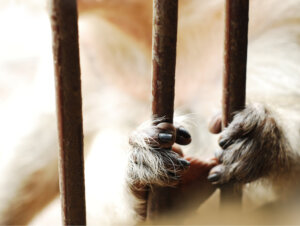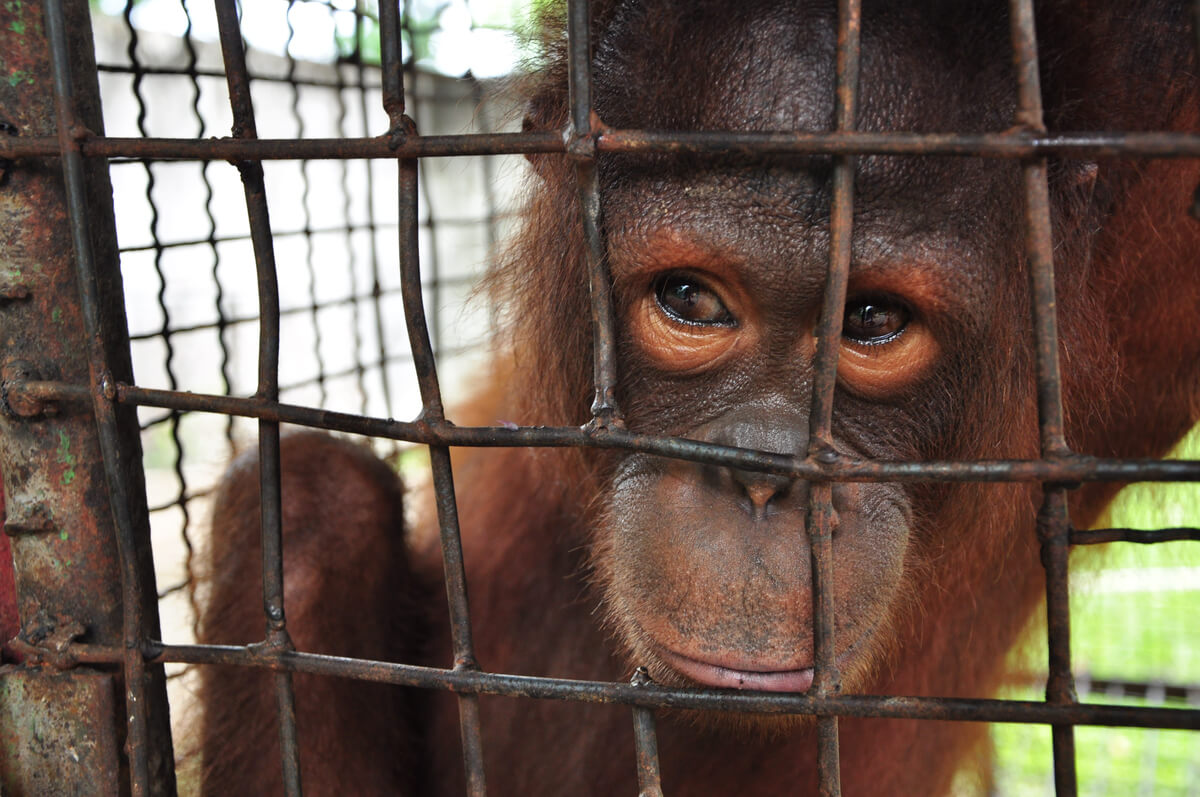How Captivity-Induced Stress Changes the Physiology of Different Species

Mimic the natural habitat as much as possible – that’s the main advice for those who keep wild animals confined for various reasons. However, captivity-induced stress shows that this is easier said than done, as no animal enjoys living locked up.
Several studies have undertaken the task of demonstrating this, and here we’ll bring you the most significant results as far as physiological aspects are concerned. Knowing about them isn’t only helpful for those who need to keep captive animals before reintroducing them, but also helps to raise awareness of the reality of animals who are currently confined with no apparent chance of freedom.
How confinement affects animals

Humans typically think that it’s enough for any living being to have water, food, and sleep in order to live happily. However, the pandemic that broke out in 2020 showed us something once and for all: confinement, even with all our needs met and all the entertainment in the world, negatively affects physical and psychological health.
It’s exactly the same for animals. Captivity is perceived as threatening and continuous, and the consequent physiological effects never subside. The physiology of this state is activated by two main stages:
- The adrenomedullary response: Epinephrine and norepinephrine are immediately released from the adrenal medulla when the danger of being locked in is perceived. Thus, the body is alerted to respond to a life or death situation, with increased heart rate, muscle tone, and blood pressure, among others.
- Glucocorticoid release: This second stage begins within minutes of the onset of the stressor. These steroid hormones have a significant effect on the regulation of the metabolism, which prepares the body to cope with the dangerous situation for a longer period of time. This stops the body from investing in long-term processes such as the immune system or reproduction.
As you might imagine, these two processes are designed to resolve a momentary situation. However, when the perception of threat doesn’t diminish, the body continues to release corticosteroids, affecting the animal’s health. This is known as chronic stress, in this case induced by captivity.
Captivity-induced stress and glucocorticoids
It’s these glucocorticoids that keep the body responding to a continuous threat, sacrificing the normal functioning of some systems to maintain immediate alertness. The results of studies in this regard are revealing:
- When analyzing weight, 60% of the studies found that animals that had been locked up never regained the weight they lost due to stress.
- Nearly half of the studies (42%) showed that the captured animals had higher glucocorticoid levels than their free-living counterparts.
- Forty-five percent of the species reviewed maintained these high glucocorticoid levels three months after capture.
To illustrate all this, here are a few examples. The first is from a study published in 2004, which found that long-term captivity led to increased adrenal mass in African green monkeys. On the other hand, in nine-banded armadillos, it was found that 6 months of captivity caused adrenal changes similar to those that occur after the stress of a harsh winter.
How does chronic stress affect the immune system?
One of the systems most affected by captivity-induced stress is the immune system. Since there’s no need to invest in it during a situation of imminent danger, the body allocates resources to other organs and processes. In the long run, therefore, it suffers and this favors the appearance of diseases.
In this respect, the synthesis of results gives rise to interesting data. Let’s look at the most striking ones:
- Twenty-four percent of the studies showed increased immune responses, while another 24% showed decreased immune responses (measured by leukocyte counts).
- The responses are not clear; it seems to be species-dependent. While some animals show a hyperactivated immune system, others suffer from problems resulting from its inhibition.
- An example of the latter are toads, in which a greater number of bacteria were found on their skin and in the digestive system when they lived in captivity.
Enclosure and reproduction
Reproduction is a function also linked to glucocorticoid levels. Indeed, these have the ability to inhibit (or even suppress) reproductive steroids. Therefore, lower testosterone or estradiol production will have effects on the reproductive behavior of the animals.
In young specimens, moreover, the stress of living in captivity causes problems in the development of the gonads and maturation of the eggs.
When looking at the reproductive system, the authors of the study found that 74% of the articles show that wild-caught animals have an inhibited reproductive capacity. This is observed in numerous cases and is problematic, especially for those species that are intended to be bred in captivity and then released.

Many animals are locked up for various human purposes: experimentation, livestock farms, entertainment, and so on. How many of these can be prevented? Where can we direct the development of our species without harming other animals? Fortunately, there are already people working on it, so all that remains is to support them so that fewer and fewer animals have to suffer life-long confinement and captivity-induced stress.
Mimic the natural habitat as much as possible – that’s the main advice for those who keep wild animals confined for various reasons. However, captivity-induced stress shows that this is easier said than done, as no animal enjoys living locked up.
Several studies have undertaken the task of demonstrating this, and here we’ll bring you the most significant results as far as physiological aspects are concerned. Knowing about them isn’t only helpful for those who need to keep captive animals before reintroducing them, but also helps to raise awareness of the reality of animals who are currently confined with no apparent chance of freedom.
How confinement affects animals

Humans typically think that it’s enough for any living being to have water, food, and sleep in order to live happily. However, the pandemic that broke out in 2020 showed us something once and for all: confinement, even with all our needs met and all the entertainment in the world, negatively affects physical and psychological health.
It’s exactly the same for animals. Captivity is perceived as threatening and continuous, and the consequent physiological effects never subside. The physiology of this state is activated by two main stages:
- The adrenomedullary response: Epinephrine and norepinephrine are immediately released from the adrenal medulla when the danger of being locked in is perceived. Thus, the body is alerted to respond to a life or death situation, with increased heart rate, muscle tone, and blood pressure, among others.
- Glucocorticoid release: This second stage begins within minutes of the onset of the stressor. These steroid hormones have a significant effect on the regulation of the metabolism, which prepares the body to cope with the dangerous situation for a longer period of time. This stops the body from investing in long-term processes such as the immune system or reproduction.
As you might imagine, these two processes are designed to resolve a momentary situation. However, when the perception of threat doesn’t diminish, the body continues to release corticosteroids, affecting the animal’s health. This is known as chronic stress, in this case induced by captivity.
Captivity-induced stress and glucocorticoids
It’s these glucocorticoids that keep the body responding to a continuous threat, sacrificing the normal functioning of some systems to maintain immediate alertness. The results of studies in this regard are revealing:
- When analyzing weight, 60% of the studies found that animals that had been locked up never regained the weight they lost due to stress.
- Nearly half of the studies (42%) showed that the captured animals had higher glucocorticoid levels than their free-living counterparts.
- Forty-five percent of the species reviewed maintained these high glucocorticoid levels three months after capture.
To illustrate all this, here are a few examples. The first is from a study published in 2004, which found that long-term captivity led to increased adrenal mass in African green monkeys. On the other hand, in nine-banded armadillos, it was found that 6 months of captivity caused adrenal changes similar to those that occur after the stress of a harsh winter.
How does chronic stress affect the immune system?
One of the systems most affected by captivity-induced stress is the immune system. Since there’s no need to invest in it during a situation of imminent danger, the body allocates resources to other organs and processes. In the long run, therefore, it suffers and this favors the appearance of diseases.
In this respect, the synthesis of results gives rise to interesting data. Let’s look at the most striking ones:
- Twenty-four percent of the studies showed increased immune responses, while another 24% showed decreased immune responses (measured by leukocyte counts).
- The responses are not clear; it seems to be species-dependent. While some animals show a hyperactivated immune system, others suffer from problems resulting from its inhibition.
- An example of the latter are toads, in which a greater number of bacteria were found on their skin and in the digestive system when they lived in captivity.
Enclosure and reproduction
Reproduction is a function also linked to glucocorticoid levels. Indeed, these have the ability to inhibit (or even suppress) reproductive steroids. Therefore, lower testosterone or estradiol production will have effects on the reproductive behavior of the animals.
In young specimens, moreover, the stress of living in captivity causes problems in the development of the gonads and maturation of the eggs.
When looking at the reproductive system, the authors of the study found that 74% of the articles show that wild-caught animals have an inhibited reproductive capacity. This is observed in numerous cases and is problematic, especially for those species that are intended to be bred in captivity and then released.

Many animals are locked up for various human purposes: experimentation, livestock farms, entertainment, and so on. How many of these can be prevented? Where can we direct the development of our species without harming other animals? Fortunately, there are already people working on it, so all that remains is to support them so that fewer and fewer animals have to suffer life-long confinement and captivity-induced stress.
All cited sources were thoroughly reviewed by our team to ensure their quality, reliability, currency, and validity. The bibliography of this article was considered reliable and of academic or scientific accuracy.
- Suleman, M. A., Wango, E., Sapolsky, R. M., Odongo, H., & Hau, J. (2004). Physiologic manifestations of stress from capture and restraint of free-ranging male African green monkeys (Cercopithecus aethiops). Journal of Zoo and Wildlife Medicine, 35(1), 20-24.
- Rideout, B. A., Gause, G. E., Benirschke, K., & Lasley, B. L. (1985). Stress‐induced adrenal changes and their relation to reproductive failure in captive nine‐banded armadillos (Dasypus novemcinctus). Zoo biology, 4(2), 129-137.
- Fischer, C. P., & Romero, L. M. (2019). Chronic captivity stress in wild animals is highly species-specific. Conservation physiology, 7(1), coz093.
This text is provided for informational purposes only and does not replace consultation with a professional. If in doubt, consult your specialist.








